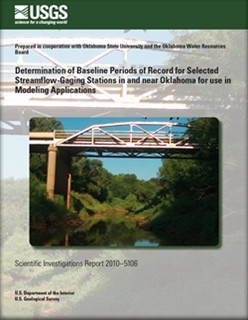
Product Details
- Product Number
- 116744
- Series
- SIR-2010-5106
- Scale
- NO SCALE
- Alternate ID
- 105106
- ISBN
- 978-1-4113-2864-8
- Authors
- RACHEL A ESRALEW
- Version Date
- 01/01/2010
- Regions
- OK
- Countries
- USA
Additional Details
- Description
- Use of historical streamflow data from a least-altered period of record can be used in calibration of various modeling applications that are used to characterize least-altered flow and predict the effects of proposed streamflow alteration. This information can be used to enhance water-resources planning. A baseline period of record was determined for selected streamflow-gaging stations that can be used as a calibration dataset for modeling applications. The baseline period of record was defined as a period that is least-altered by anthropogenic activity and has sufficient streamflow record length to represent extreme climate variability. Streamflow data from 171 stations in and near Oklahoma with a minimum of 10 complete water years of daily streamflow record through water year 2007 and drainage areas that were less than 2,500 square miles were considered for use in the baseline period analysis. The first step to determine the least-altered period of record was to evaluate station information by using previous publications, historical station record notes, and information gathered from oral and written communication with hydrographers familiar with selected stations. The second step was to indentify stations that had substantial effects from upstream regulation by evaluating the location and extent of dams in the drainage basin. The third step was (a) the analysis of annual hydrographs and included visual hydrograph analysis for selected stations with 20 or more years of streamflow record, (b) analysis of covariance of double-mass curves, and (c) Kendall#s tau trend analysis to detect statistically significant trends in base flow, runoff, total flow, and base-flow index related to anthropogenic activity for selected stations with 15 or more years of streamflow record. A preliminary least-altered period of record for each stream was identified by removing the period of streamflow record when streams were substantially affected by anthropogenic activity. After streamflow record was removed from designation as a least-altered period, stations that did not have at least 10 years of remaining continuous streamflow record were considered to have an insufficient baseline period for modeling applications. An optimum minimum period of record was determined for each of the least-altered periods for each station to ensure a sufficient streamflow record length to provide a representative sample of annual climate variability. An optimum minimum period of 10 years or more was evaluated by analyzing the variability of annual precipitation for selected 5-, 10-, 15-, 25-, and 35-year periods for each of 20 climate divisions that contained stations used in the baseline period analysis. The distribution of annual precipitation was compared for each consecutive overlapping 5-year period to the period 1925#2007 by using a Wilcoxon rank-sum test. The least-altered period of record for stations was also compared to the period 1925#2007 by using a Wilcoxon rank-sum test. The results of this analysis were used to determine how many years of annual precipitation data were needed for the selected period to be statistically similar to the distribution of annual precipitation data for a long-term period, 1925#2007. Minimum optimum periods ranged from 10 to 35 years and varied by climate division. A final baseline period was determined for 111 stations that had a baseline period of at least 10 years of continuous streamflow record after the record-elimination process. A suitable baseline period of record for use in modeling applications could not be identified for 58 of the initial 171 stations because of substantial anthropogenic alteration of the stream or drainage basin and for 2 stations because the least-altered period of record was not representative of annual climate variability. The baseline period for each station was rated #excellent#, #good#, #fair#, #poor#, or #no baseline period.# This rating was based on a qualitative evaluation of the approximate degree of basin alteration for the least-altered period of record, and whether or not the least-altered period was long enough to be representative of long-term climate variability. Baseline periods of record were rated as #excellent# for 22 stations, #good# for 42 stations, #fair# for 24 stations, and #poor# for 23 stations.
Related Items




